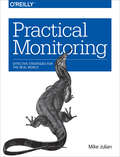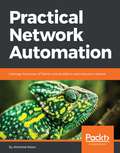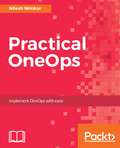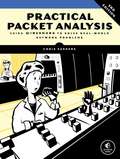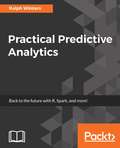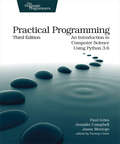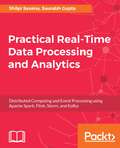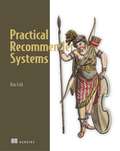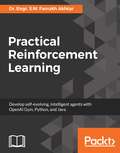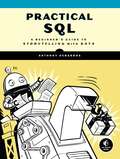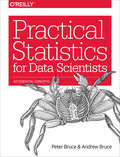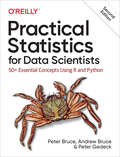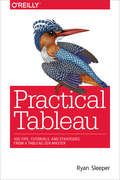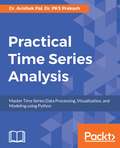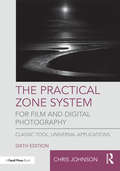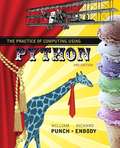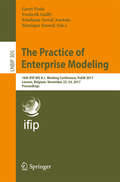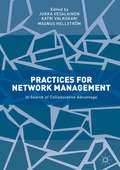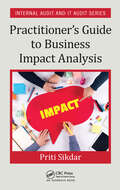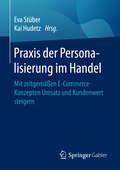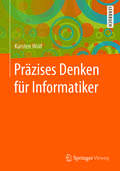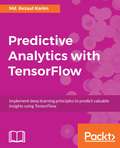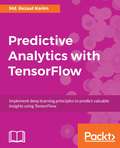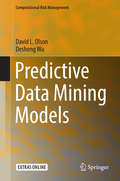- Table View
- List View
Practical Monitoring: Effective Strategies for the Real World
by Mike JulianDo you have a nagging feeling that your monitoring could be improved, but you just aren’t sure how? This is the book for you. Practical Monitoring explains what makes your monitoring less than stellar, and provides a practical approach to designing and implementing a monitoring strategy, from the application down to the hardware in the datacenter and everything in between.In the world of technical operations, monitoring is core to everything you do. In today’s changing landscape of microservices, cloud infrastructure, and more, monitoring is experiencing a new surge of growth, bringing along new methodologies, new ways of thinking, and new tools.Complete with a primer on statistics and a monitoring vocabulary, this book helps you identify the main areas you need to monitor and shows you how to approach them. It’s ideal for operations engineers, system administrators, system and software engineers, site reliability engineers, network engineers, and other operations professionals.
Practical Network Automation: Leverage the power of Python and Ansible to optimize your network
by Abhishek RatanGet More from your Network with Automation tools to increase its effectiveness. About This Book • Get started with network automation (and different automation tasks) with relevant use cases • Apply software design principles such as Continuous Integration and DevOps to your network toolkit • Guides you through some best practices in automation Who This Book Is For If you are a network engineer looking for an extensive guide to help you automate and manage your network efficiently, then this book is for you. What You Will Learn • Get the detailed analysis of Network automation • Trigger automations through available data factors • Improve data center robustness and security through specific access and data digging • Get an Access to APIs from Excel for dynamic reporting • Set up a communication with SSH-based devices using netmiko • Make full use of practical use cases and best practices to get accustomed with the various aspects of network automation In Detail Network automation is the use of IT controls to supervise and carry out every-day network management functions. It plays a key role in network virtualization technologies and network functions. The book starts by providing an introduction to network automation, SDN, and its applications, which include integrating DevOps tools to automate the network efficiently. It then guides you through different network automation tasks and covers various data digging and reporting methodologies such as IPv6 migration, DC relocations, and interface parsing, all the while retaining security and improving data center robustness. The book then moves on to the use of Python and the management of SSH keys for machine-to-machine (M2M) communication, all followed by practical use cases. The book also covers the importance of Ansible for network automation including best practices in automation, ways to test automated networks using different tools, and other important techniques. By the end of the book, you will be well acquainted with the various aspects of network automation. Style and approach A clear, concise, and straightforward book that will enable you to automate networks and improve performance.
Practical OneOps
by Nilesh NimkarImplement DevOps with easeAbout This BookLeverage OneOps to achieve continuous application lifecycle managementSwitch between multiple cloud providers in order to leverage better pricing, technology, and scalabilityBuild complex environments in a repeatable and predictable method, and deploy and scale on multiple cloudsWho This Book Is ForThis book targets DevOps who want to use OneOps daily to deploy their applications, and Sysadmins who will be administering those applications.What You Will LearnLearn how to install OneOpsConfigure OneOps, including customizing your organizations, teams and cloudsWork through practical deployment scenariosUnderstand OneOps architecture and individual components like Circuit and DisplayBuild custom components and add unsupported clouds programmatically to OneOpsExtend OneOps by calling the REST APIIn DetailWalmart’s OneOps is an open source DevOps platform that is used for cloud and application lifecycle management. It can manage critical and complex application workload on any multi cloud-based infrastructure and revolutionizes the way administrators, developers, and engineers develop and launch new products.This practical book focuses on real-life cases and hands-on scenarios to develop, launch, and test your applications faster, so you can implement the DevOps process using OneOps.You will be exposed to the fundamental aspects of OneOps starting with installing, deploying, and configuring OneOps in a test environment, which will also come in handy later for development and debugging. You will also learn about design and architecture, and work through steps to perform enterprise level deployment. You will understand the initial setup of OneOps such as creating organization, teams, and access management. Finally, you will be taught how to configure, repair, scale, and extend applications across various cloud platforms.Style and approachA practical book packed with real life examples, practical scenarios and case studies on leveraging OneOps to implement DevOps for your organization.
Practical Packet Analysis, 3E: Using Wireshark to Solve Real-World Network Problems
by Chris SandersIt’s easy to capture packets with Wireshark, the world’s most popular network sniffer, whether off the wire or from the air. But how do you use those packets to understand what’s happening on your network?Updated to cover Wireshark 2.x, the third edition of Practical Packet Analysis will teach you to make sense of your packet captures so that you can better troubleshoot network problems. You’ll find added coverage of IPv6 and SMTP, a new chapter on the powerful command line packet analyzers tcpdump and TShark, and an appendix on how to read and reference packet values using a packet map.Practical Packet Analysis will show you how to:–Monitor your network in real time and tap live network communications–Build customized capture and display filters–Use packet analysis to troubleshoot and resolve common network problems, like loss of connectivity, DNS issues, and slow speeds–Explore modern exploits and malware at the packet level–Extract files sent across a network from packet captures–Graph traffic patterns to visualize the data flowing across your network–Use advanced Wireshark features to understand confusing captures–Build statistics and reports to help you better explain technical network information to non-techiesNo matter what your level of experience is, Practical Packet Analysis will show you how to use Wireshark to make sense of any network and get things done.
Practical Predictive Analytics
by Ralph WintersMake sense of your data and predict the unpredictable About This Book • A unique book that centers around develop six key practical skills needed to develop and implement predictive analytics • Apply the principles and techniques of predictive analytics to effectively interpret big data • Solve real-world analytical problems with the help of practical case studies and real-world scenarios taken from the world of healthcare, marketing, and other business domains Who This Book Is For This book is for those with a mathematical/statistics background who wish to understand the concepts, techniques, and implementation of predictive analytics to resolve complex analytical issues. Basic familiarity with a programming language of R is expected. What You Will Learn • Master the core predictive analytics algorithm which are used today in business • Learn to implement the six steps for a successful analytics project • Classify the right algorithm for your requirements • Use and apply predictive analytics to research problems in healthcare • Implement predictive analytics to retain and acquire your customers • Use text mining to understand unstructured data • Develop models on your own PC or in Spark/Hadoop environments • Implement predictive analytics products for customers In Detail This is the go-to book for anyone interested in the steps needed to develop predictive analytics solutions with examples from the world of marketing, healthcare, and retail. We'll get started with a brief history of predictive analytics and learn about different roles and functions people play within a predictive analytics project. Then, we will learn about various ways of installing R along with their pros and cons, combined with a step-by-step installation of RStudio, and a description of the best practices for organizing your projects. On completing the installation, we will begin to acquire the skills necessary to input, clean, and prepare your data for modeling. We will learn the six specific steps needed to implement and successfully deploy a predictive model starting from asking the right questions through model development and ending with deploying your predictive model into production. We will learn why collaboration is important and how agile iterative modeling cycles can increase your chances of developing and deploying the best successful model. We will continue your journey in the cloud by extending your skill set by learning about Databricks and SparkR, which allow you to develop predictive models on vast gigabytes of data. Style and Approach This book takes a practical hands-on approach wherein the algorithms will be explained with the help of real-world use cases. It is written in a well-researched academic style which is a great mix of theoretical and practical information. Code examples are supplied for both theoretical concepts as well as for the case studies. Key references and summaries will be provided at the end of each chapter so that you can explore those topics on their own.
Practical Programming: An Introduction to Computer Science Using Python 3.6
by Paul Gries Jennifer Campbell Jason MontojoClassroom-tested by tens of thousands of students, this new edition of the bestselling intro to programming book is for anyone who wants to understand computer science. Learn about design, algorithms, testing, and debugging. Discover the fundamentals of programming with Python 3.6--a language that's used in millions of devices. Write programs to solve real-world problems, and come away with everything you need to produce quality code. This edition has been updated to use the new language features in Python 3.6.
Practical Real-time Data Processing and Analytics
by Shilpi Saxena Saurabh GuptaA practical guide to help you tackle different real-time data processing and analytics problems using the best tools for each scenario About This Book • Learn about the various challenges in real-time data processing and use the right tools to overcome them • This book covers popular tools and frameworks such as Spark, Flink, and Apache Storm to solve all your distributed processing problems • A practical guide filled with examples, tips, and tricks to help you perform efficient Big Data processing in real-time Who This Book Is For If you are a Java developer who would like to be equipped with all the tools required to devise an end-to-end practical solution on real-time data streaming, then this book is for you. Basic knowledge of real-time processing would be helpful, and knowing the fundamentals of Maven, Shell, and Eclipse would be great. What You Will Learn • Get an introduction to the established real-time stack • Understand the key integration of all the components • Get a thorough understanding of the basic building blocks for real-time solution designing • Garnish the search and visualization aspects for your real-time solution • Get conceptually and practically acquainted with real-time analytics • Be well equipped to apply the knowledge and create your own solutions In Detail With the rise of Big Data, there is an increasing need to process large amounts of data continuously, with a shorter turnaround time. Real-time data processing involves continuous input, processing and output of data, with the condition that the time required for processing is as short as possible. This book covers the majority of the existing and evolving open source technology stack for real-time processing and analytics. You will get to know about all the real-time solution aspects, from the source to the presentation to persistence. Through this practical book, you'll be equipped with a clear understanding of how to solve challenges on your own. We'll cover topics such as how to set up components, basic executions, integrations, advanced use cases, alerts, and monitoring. You'll be exposed to the popular tools used in real-time processing today such as Apache Spark, Apache Flink, and Storm. Finally, you will put your knowledge to practical use by implementing all of the techniques in the form of a practical, real-world use case. By the end of this book, you will have a solid understanding of all the aspects of real-time data processing and analytics, and will know how to deploy the solutions in production environments in the best possible manner. Style and Approach In this practical guide to real-time analytics, each chapter begins with a basic high-level concept of the topic, followed by a practical, hands-on implementation of each concept, where you can see the working and execution of it. The book is written in a DIY style, with plenty of practical use cases, well-explained code examples, and relevant screenshots and diagrams.
Practical Recommender Systems
by Kim FalkSummaryOnline recommender systems help users find movies, jobs, restaurants-even romance! There's an art in combining statistics, demographics, and query terms to achieve results that will delight them. Learn to build a recommender system the right way: it can make or break your application!Purchase of the print book includes a free eBook in PDF, Kindle, and ePub formats from Manning Publications.About the TechnologyRecommender systems are everywhere, helping you find everything from movies to jobs, restaurants to hospitals, even romance. Using behavioral and demographic data, these systems make predictions about what users will be most interested in at a particular time, resulting in high-quality, ordered, personalized suggestions. Recommender systems are practically a necessity for keeping your site content current, useful, and interesting to your visitors.About the BookPractical Recommender Systems explains how recommender systems work and shows how to create and apply them for your site. After covering the basics, you'll see how to collect user data and produce personalized recommendations. You'll learn how to use the most popular recommendation algorithms and see examples of them in action on sites like Amazon and Netflix. Finally, the book covers scaling problems and other issues you'll encounter as your site grows.What's insideHow to collect and understand user behaviorCollaborative and content-based filteringMachine learning algorithms Real-world examples in PythonAbout the ReaderReaders need intermediate programming and database skills.About the AuthorKim Falk is an experienced data scientist who works daily with machine learning and recommender systems.Table of ContentsPART 1 - GETTING READY FOR RECOMMENDER SYSTEMSWhat is a recommender? User behavior and how to collect it Monitoring the system Ratings and how to calculate themNon-personalized recommendationsThe user (and content) who came in from the coldPART 2 - RECOMMENDER ALGORITHMSFinding similarities among users and among contentCollaborative filtering in the neighborhoodEvaluating and testing your recommenderContent-based filteringFinding hidden genres with matrix factorizationTaking the best of all algorithms: implementing hybrid recommendersRanking and learning to rankFuture of recommender systems
Practical Reinforcement Learning
by Dr Engr. AkhtarMaster different reinforcement learning techniques and their practical implementation using OpenAI Gym, Python and Java About This Book • Take your machine learning skills to the next level with reinforcement learning techniques • Build automated decision-making capabilities in your systems • Cover Reinforcement Learning concepts, frameworks, algorithms, and more in detail Who This Book Is For Machine learning/AI practitioners, data scientists, data analysts, machine learning engineers, and developers who are looking to expand their existing knowledge to build optimized machine learning models, will find this book very useful. What You Will Learn • Understand the basics of reinforcement learning methods, algorithms, and more, and the differences between supervised, unsupervised, and reinforcement learning • Master the Markov Decision Process math framework by building an OO-MDP Domain in Java • Learn dynamic programming principles and the implementation of Fibonacci computation in Java • Understand Python implementation of temporal difference learning • Develop Monte Carlo methods and various policies used to build a Monte Carlo simulator using Python • Understand Policy Gradient methods and policies applied in the reinforcement domain • Instill reinforcement methods in the autonomous platform using a moving car example • Apply reinforcement learning algorithms in games with REINFORCEjs In Detail Reinforcement learning (RL) is becoming a popular tool for constructing autonomous systems that can improve themselves with experience. We will break the RL framework into its core building blocks, and provide you with details of each element. This book aims to strengthen your machine learning skills by acquainting you with reinforcement learning algorithms and techniques. This book is divided into three parts. The first part defines Reinforcement Learning and describes its basics. It also covers the basics of Python and Java frameworks, which we are going to use later in the book. The second part discusses learning techniques with basic algorithms such as Temporal Difference, Monte Carlo, and Policy Gradient—all with practical examples. Lastly, in the third part we apply Reinforcement Learning with the most recent and widely used algorithms via practical applications. By the end of this book, you'll know the practical implementation of case studies and current research activities to help you advance further with Reinforcement Learning. Style and approach This hands-on book will further expand your machine learning skills by teaching you the different reinforcement learning algorithms and techniques using practical examples.
Practical SQL: A Beginner's Guide to Storytelling with Data
by Anthony DeBarrosPractical SQL is an approachable and fast-paced guide to SQL (Structured Query Language), the standard programming language for defining, organizing, and exploring data in relational databases. The book focuses on using SQL to find the story your data tells, with the popular open-source database PostgreSQL and the pgAdmin interface as its primary tools. You’ll first cover the fundamentals of databases and the SQL language, then build skills by analyzing data from the U.S. Census and other federal and state government agencies. With exercises and real-world examples in each chapter, this book will teach even those who have never programmed before all the tools necessary to build powerful databases and access information quickly and efficiently. You’ll learn how to: -Create databases and related tables using your own data -Define the right data types for your information -Aggregate, sort, and filter data to find patterns -Use basic math and advanced statistical functions -Identify errors in data and clean them up -Import and export data using delimited text files -Write queries for geographic information systems (GIS) -Create advanced queries and automate tasks Learning SQL doesn’t have to be dry and complicated. Practical SQL delivers clear examples with an easy-to-follow approach to teach you the tools you need to build and manage your own databases. This book uses PostgreSQL, but the SQL syntax is applicable to many database applications, including Microsoft SQL Server and MySQL.
Practical Statistics for Data Scientists: 50 Essential Concepts
by Peter Bruce Andrew BruceStatistical methods are a key part of of data science, yet very few data scientists have any formal statistics training. Courses and books on basic statistics rarely cover the topic from a data science perspective. This practical guide explains how to apply various statistical methods to data science, tells you how to avoid their misuse, and gives you advice on what's important and what's not.Many data science resources incorporate statistical methods but lack a deeper statistical perspective. If you’re familiar with the R programming language, and have some exposure to statistics, this quick reference bridges the gap in an accessible, readable format.With this book, you’ll learn:Why exploratory data analysis is a key preliminary step in data scienceHow random sampling can reduce bias and yield a higher quality dataset, even with big dataHow the principles of experimental design yield definitive answers to questionsHow to use regression to estimate outcomes and detect anomaliesKey classification techniques for predicting which categories a record belongs toStatistical machine learning methods that “learn” from dataUnsupervised learning methods for extracting meaning from unlabeled data
Practical Statistics for Data Scientists: 50+ Essential Concepts Using R and Python
by Peter Bruce Andrew Bruce Peter GedeckStatistical methods are a key part of data science, yet few data scientists have formal statistical training. Courses and books on basic statistics rarely cover the topic from a data science perspective. The second edition of this popular guide adds comprehensive examples in Python, provides practical guidance on applying statistical methods to data science, tells you how to avoid their misuse, and gives you advice on what’s important and what’s not.Many data science resources incorporate statistical methods but lack a deeper statistical perspective. If you’re familiar with the R or Python programming languages and have some exposure to statistics, this quick reference bridges the gap in an accessible, readable format.With this book, you’ll learn:Why exploratory data analysis is a key preliminary step in data scienceHow random sampling can reduce bias and yield a higher-quality dataset, even with big dataHow the principles of experimental design yield definitive answers to questionsHow to use regression to estimate outcomes and detect anomaliesKey classification techniques for predicting which categories a record belongs toStatistical machine learning methods that "learn" from dataUnsupervised learning methods for extracting meaning from unlabeled data
Practical Tableau: 100 Tips, Tutorials, and Strategies from a Tableau Zen Master
by Ryan SleeperWhether you have some experience with Tableau software or are just getting started, this manual goes beyond the basics to help you build compelling, interactive data visualization applications. Author Ryan Sleeper, one of the world’s most qualified Tableau consultants, complements his web posts and instructional videos with this guide to give you a firm understanding of how to use Tableau to find valuable insights in data.Over five sections, Sleeper—recognized as a Tableau Zen Master, Tableau Public Visualization of the Year author, and Tableau Iron Viz Champion—provides visualization tips, tutorials, and strategies to help you avoid the pitfalls and take your Tableau knowledge to the next level.Practical Tableau sections include:Fundamentals: get started with Tableau from the beginningChart types: use step-by-step tutorials to build a variety of charts in TableauTips and tricks: learn innovative uses of parameters, color theory, how to make your Tableau workbooks run efficiently, and moreFramework: explore the INSIGHT framework, a proprietary process for building Tableau dashboardsStorytelling: learn tangible tactics for storytelling with data, including specific and actionable tips you can implement immediately
Practical Time-Series Analysis
by Dr Pks Prakash Dr Avishek PalStep by Step guide filled with real world practical examples. About This Book • Get your first experience with data analysis with one of the most powerful types of analysis—time-series. • Find patterns in your data and predict the future pattern based on historical data. • Learn the statistics, theory, and implementation of Time-series methods using this example-rich guide Who This Book Is For This book is for anyone who wants to analyze data over time and/or frequency. A statistical background is necessary to quickly learn the analysis methods. What You Will Learn • Understand the basic concepts of Time Series Analysis and appreciate its importance for the success of a data science project • Develop an understanding of loading, exploring, and visualizing time-series data • Explore auto-correlation and gain knowledge of statistical techniques to deal with non-stationarity time series • Take advantage of exponential smoothing to tackle noise in time series data • Learn how to use auto-regressive models to make predictions using time-series data • Build predictive models on time series using techniques based on auto-regressive moving averages • Discover recent advancements in deep learning to build accurate forecasting models for time series • Gain familiarity with the basics of Python as a powerful yet simple to write programming language In Detail Time Series Analysis allows us to analyze data which is generated over a period of time and has sequential interdependencies between the observations. This book describes special mathematical tricks and techniques which are geared towards exploring the internal structures of time series data and generating powerful descriptive and predictive insights. Also, the book is full of real-life examples of time series and their analyses using cutting-edge solutions developed in Python. The book starts with descriptive analysis to create insightful visualizations of internal structures such as trend, seasonality and autocorrelation. Next, the statistical methods of dealing with autocorrelation and non-stationary time series are described. This is followed by exponential smoothing to produce meaningful insights from noisy time series data. At this point, we shift focus towards predictive analysis and introduce autoregressive models such as ARMA and ARIMA for time series forecasting. Later, powerful deep learning methods are presented, to develop accurate forecasting models for complex time series, and under the availability of little domain knowledge. All the topics are illustrated with real-life problem scenarios and their solutions by best-practice implementations in Python. The book concludes with the Appendix, with a brief discussion of programming and solving data science problems using Python. Style and approach This book takes the readers from the basic to advance level of Time series analysis in a very practical and real world use cases.
The Practical Zone System for Film and Digital Photography: Classic Tool, Universal Applications
by Chris JohnsonThis sixth edition of The Practical Zone System by Chris Johnson updates the classic manual on Ansel Adams's landmark technique for the digital age. For photographers working digitally or with film, in color or black and white, in the studio or on the go, this simple visual language helps to control contrast and, through a process called Previsualization, provides photographers with the power of free creative expression. This new edition discusses recent advances in technology and potentials for their use in zone photography, including HDR, smartphone cameras that shoot in raw format and smartphone light meters. Johnson demonstrates how the Zone System is a universal visual and conceptual language that dramatically simplifies the problem of creating and rendering complex lighting setups.
The Practice Of Computing Using Python
by Richard Enbody William PunchNow in its Third Edition, Practice of Computing Using Python continues to effectively introduce readers to computational thinking using Python, with a strong emphasis on problem solving through computer science. The authors have chosen Python for its simplicity, powerful built-in data structures, advanced control constructs, and practicality. The text is built from the ground up for Python programming, rather than having been translated from Java or C++.
The Practice of Enterprise Modeling: 10th IFIP WG 8.1. Working Conference, PoEM 2017, Leuven, Belgium, November 22-24, 2017, Proceedings (Lecture Notes in Business Information Processing #305)
by Geert Poels, Frederik Gailly, Estefania Serral Asensio and Monique SnoeckThis volume constitutes the proceedings of the 10th IFIP WG 8.1 Conference on the Practice of Enterprise Modeling held in November 2017 in Leuven, Belgium. The conference was created by the International Federation for Information Processing (IFIP) Working Group 8.1 to offer a forum for knowledge transfer and experience sharing between the academic and practitioner communities. The 20 full papers and 4 short papers accepted were carefully reviewed and selected from 70 submissions. They include research results, practitioner/experience reports and work-in-progress papers and were presented in 8 sessions covering diverse topics related to enterprise modelling and its application in practice.
Practices for Network Management
by Jukka Vesalainen Katri Valkokari Magnus HellströmPresenting 17 tools developed through rigorous design science research, this book bridges the relevance gap within network management. In so doing, it proposes a novel system-framework and establishes a path towards a networks-as-practice view on inter-organizational relationships. The systems-framework builds on three institutionalized business practices: Networks-as-coordinated social systems, Networks-as-knowledge-creating platforms, and Networks-as-value-generating entities. Through these tools, Towards Relational Business Practices intends to propose a new managerial praxis and provoke new and improved frameworks and models for network management.
Practitioner's Guide to Business Impact Analysis (Security, Audit and Leadership Series)
by Priti SikdarThis book illustrates the importance of business impact analysis, which covers risk assessment, and moves towards better understanding of the business environment, industry specific compliance, legal and regulatory landscape and the need for business continuity. The book provides charts, checklists and flow diagrams that give the roadmap to collect, collate and analyze data, and give enterprise management the entire mapping for controls that comprehensively covers all compliance that the enterprise is subject to have. The book helps professionals build a control framework tailored for an enterprise that covers best practices and relevant standards applicable to the enterprise. Presents a practical approach to assessing security, performance and business continuity needs of the enterprise Helps readers understand common objectives for audit, compliance, internal/external audit and assurance. Demonstrates how to build a customized controls framework that fulfills common audit criteria, business resilience needs and internal monitoring for effectiveness of controls Presents an Integrated Audit approach to fulfill all compliance requirements
Praxis der Personalisierung im Handel
by Eva Stüber Kai HudetzPersonalisierung gilt im Handel als wichtiger Wettbewerbsvorteil. Dieses Buch zeigt, wie der Handel mittels zeitgemäßer E-Commerce-Technologie kundenindividuelle Angebote erzeugen kann, um Umsätze und den Kundenwert zu steigern. Autoren aus der Forschung, Beratung und Praxis erklären die Möglichkeiten und Wirkungen der Personalisierung und geben einen Ausblick auf zukünftige Entwicklungen. Fallbeispiele von bekannten Onlinehändlern illustrieren den Best Practice. Obwohl über das Thema viel gesprochen wird, gibt es viele offene Fragen von der Konzeption über Realisierungsoptionen bis hin zu rechtlichen Aspekten. Dieses Buch liefert Antworten.
Präzises Denken für Informatiker
by Karsten WolfDas Lehrbuch befasst sich mit dem präzisen Denken, einer Schlüsselkompetenz im Studium der Informatik. Es bildet die Vorstufe für das Verständnis der logischen Grundfunktionen der Informatik. Das Erlernen der mathematischen Logik ist ein wesentlicher Bestandteil des Grundstudiums, da das logische Denken in der Informatik auf den gleichen Regeln und Techniken basiert wie in der Mathematik. Der Autor führt umfassend in die Aussagenlogik ein und erklärt unter anderem die Bedeutungen von logischer Äquivalenz, Implikation und Induktion für diesen Fachbereich. Darüber hinaus definiert er den Beweis aus Sicht der Mathematik und stellt grundlegende Beweisstrategien vor, die im Studium benötigt werden. Mit den in diesem Lehrbuch vorgestellten Techniken des präzisen Denkens erwerben die Studenten die Fähigkeit, Begriffe punktgenau zu definieren, Aussagen trennscharf zu formulieren und ihre Richtigkeit angemessen zu begründen. Viele praxisnahe Aufgaben und Lösungshinweise innerhalb der Kapitel erleichtern die Überprüfung und Vertiefung des Lernstoffs. Der Autor richtet sich vornehmlich an Bachelorstudenten der ersten Semester. Sie finden in diesem Werk eine optimale Vorbereitung auf die Logik-Seminare ihres Informatikstudiums. Die vermittelten Kompetenzen verbessern dabei nicht nur das Verständnis im Informatik-Studium, sondern sind ebenso für das spätere Berufsleben von großer Bedeutung. Darüber hinaus erhalten auch interessierte Laien mit diesem Buch einen interessanten Einblick in die Welt der Informatik und Mathematik und lernen, dass die Fähigkeit zu präzisem Denken auch jenseits dieser Fachbereiche hilfreich sein kann.
Predictive Analytics with TensorFlow: Implement deep learning principles to predict valuable insights using TensorFlow
by Md. Rezaul KarimAccomplish the power of data in your business by building advanced predictive modelling applications with Tensorflow. About This Book • A quick guide to gain hands-on experience with deep learning in different domains such as digit/image classification, and texts • Build your own smart, predictive models with TensorFlow using easy-to-follow approach mentioned in the book • Understand deep learning and predictive analytics along with its challenges and best practices Who This Book Is For This book is intended for anyone who wants to build predictive models with the power of TensorFlow from scratch. If you want to build your own extensive applications which work, and can predict smart decisions in the future then this book is what you need! What You Will Learn • Get a solid and theoretical understanding of linear algebra, statistics, and probability for predictive modeling • Develop predictive models using classification, regression, and clustering algorithms • Develop predictive models for NLP • Learn how to use reinforcement learning for predictive analytics • Factorization Machines for advanced recommendation systems • Get a hands-on understanding of deep learning architectures for advanced predictive analytics • Learn how to use deep Neural Networks for predictive analytics • See how to use recurrent Neural Networks for predictive analytics • Convolutional Neural Networks for emotion recognition, image classification, and sentiment analysis In Detail Predictive analytics discovers hidden patterns from structured and unstructured data for automated decision-making in business intelligence. This book will help you build, tune, and deploy predictive models with TensorFlow in three main sections. The first section covers linear algebra, statistics, and probability theory for predictive modeling. The second section covers developing predictive models via supervised (classification and regression) and unsupervised (clustering) algorithms. It then explains how to develop predictive models for NLP and covers reinforcement learning algorithms. Lastly, this section covers developing a factorization machines-based recommendation system. The third section covers deep learning architectures for advanced predictive analytics, including deep neural networks and recurrent neural networks for high-dimensional and sequence data. Finally, convolutional neural networks are used for predictive modeling for emotion recognition, image classification, and sentiment analysis. Style and approach TensorFlow, a popular library for machine learning, embraces the innovation and community-engagement of open source, but has the support, guidance, and stability of a large corporation.
Predictive Analytics with TensorFlow
by Rezaul KarimAccomplish the power of data in your business by building advanced predictive modelling applications with Tensorflow. About This Book A quick guide to gain hands-on experience with deep learning in different domains such as digit/image classification, and texts Build your own smart, predictive models with TensorFlow using easy-to-follow approach mentioned in the book Understand deep learning and predictive analytics along with its challenges and best practices Who This Book Is For This book is intended for anyone who wants to build predictive models with the power of TensorFlow from scratch. If you want to build your own extensive applications which work, and can predict smart decisions in the future then this book is what you need! What You Will Learn Get a solid and theoretical understanding of linear algebra, statistics, and probability for predictive modeling Develop predictive models using classification, regression, and clustering algorithms Develop predictive models for NLP Learn how to use reinforcement learning for predictive analytics Factorization Machines for advanced recommendation systems Get a hands-on understanding of deep learning architectures for advanced predictive analytics Learn how to use deep Neural Networks for predictive analytics See how to use recurrent Neural Networks for predictive analytics Convolutional Neural Networks for emotion recognition, image classification, and sentiment analysis In Detail Predictive analytics discovers hidden patterns from structured and unstructured data for automated decision-making in business intelligence. This book will help you build, tune, and deploy predictive models with TensorFlow in three main sections. The first section covers linear algebra, statistics, and probability theory for predictive modeling. The second section covers developing predictive models via supervised (classification and regression) and unsupervised (clustering) algorithms. It then explains how to develop predictive models for NLP and covers reinforcement learning algorithms. Lastly, this section covers developing a factorization machines-based recommendation system. The third section covers deep learning architectures for advanced predictive analytics, including deep neural networks and recurrent neural networks for high-dimensional and sequence data. Finally, convolutional neural networks are used for predictive modeling for emotion recognition, image classification, and sentiment analysis. Style and approach TensorFlow, a popular library for machine learning, embraces the innovation and community-engagement of open source, but has the support, guidance, and stability of a large corporation.
Predictive Control: for Linear and Hybrid Systems
by Francesco Borrelli Alberto Bemporad Manfred MorariModel Predictive Control (MPC), the dominant advanced control approach in industry over the past twenty-five years, is presented comprehensively in this unique book. With a simple, unified approach, and with attention to real-time implementation, it covers predictive control theory including the stability, feasibility, and robustness of MPC controllers. The theory of explicit MPC, where the nonlinear optimal feedback controller can be calculated efficiently, is presented in the context of linear systems with linear constraints, switched linear systems, and, more generally, linear hybrid systems. Drawing upon years of practical experience and using numerous examples and illustrative applications, the authors discuss the techniques required to design predictive control laws, including algorithms for polyhedral manipulations, mathematical and multiparametric programming and how to validate the theoretical properties and to implement predictive control policies. The most important algorithms feature in an accompanying free online MATLAB toolbox, which allows easy access to sample solutions. Predictive Control for Linear and Hybrid Systems is an ideal reference for graduate, postgraduate and advanced control practitioners interested in theory and/or implementation aspects of predictive control.
Predictive Data Mining Models
by David L. Olson Desheng WuThis book reviews forecasting data mining models, from basic tools for stable data through causal models, to more advanced models using trends and cycles. These models are demonstrated on the basis of business-related data, including stock indices, crude oil prices, and the price of gold. The book s main approach is above all descriptive, seeking to explain how the methods concretely work; as such, it includes selected citations, but does not go into deep scholarly reference. The data sets and software reviewed were selected for their widespread availability to all readers with internet access. "
